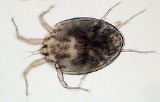
Histiostomatidae
Encyclopedia
The Histiostomatidae is a subgroup of the astigmatid mites
and branches basically in a phylogenetic tree of the Astigmata
.
These mites are characterized by a very small size (about 600–900 µm in length) and a close association to arthropodes, mainly insects. A morphologically specialized instar, the deutonymph (earlier "hypopus"), is adapted to attach e.g. insects for a phoretic transport from one habitat to another. The mites use different insect groups as phoretic carriers such as beetle
s, flies
and Hymenoptera
(ant
s, bee
s and wasp
s). In all species, the digitus mobilis of the chelicera is reduced to small rests, and the distal pedipalp
article is connected to a more or less complex membranous structure. These mouthpart modifications form an organ to feed bacteria.
Habitats are colonized by the mites such as animal dung, compost
, waterfilled treeholes or the fluids of Nepenthes
and Sarracenia
- pitcher plants.
MITES
MITES, or Minority Introduction to Engineering and Science, is a highly selective six-week summer program for rising high school seniors held at the Massachusetts Institute of Technology. Its purpose is to expose students from minority, or otherwise disadvantaged backgrounds, to the fields of...
and branches basically in a phylogenetic tree of the Astigmata
Astigmata
The Astigmatina are a "cohort" of mites. They belong to the Sarcoptiformes, which contain the "biting" Acariformes. Many species are parasites of vertebrates. Most notorious among these are the Psoroptidia, which contain such notable taxa as feather mites and Sarcoptes scabiei.The Astigmata are of...
.
These mites are characterized by a very small size (about 600–900 µm in length) and a close association to arthropodes, mainly insects. A morphologically specialized instar, the deutonymph (earlier "hypopus"), is adapted to attach e.g. insects for a phoretic transport from one habitat to another. The mites use different insect groups as phoretic carriers such as beetle
Beetle
Coleoptera is an order of insects commonly called beetles. The word "coleoptera" is from the Greek , koleos, "sheath"; and , pteron, "wing", thus "sheathed wing". Coleoptera contains more species than any other order, constituting almost 25% of all known life-forms...
s, flies
Fly
True flies are insects of the order Diptera . They possess a pair of wings on the mesothorax and a pair of halteres, derived from the hind wings, on the metathorax...
and Hymenoptera
Hymenoptera
Hymenoptera is one of the largest orders of insects, comprising the sawflies, wasps, bees and ants. There are over 130,000 recognized species, with many more remaining to be described. The name refers to the heavy wings of the insects, and is derived from the Ancient Greek ὑμήν : membrane and...
(ant
Ant
Ants are social insects of the family Formicidae and, along with the related wasps and bees, belong to the order Hymenoptera. Ants evolved from wasp-like ancestors in the mid-Cretaceous period between 110 and 130 million years ago and diversified after the rise of flowering plants. More than...
s, bee
Bee
Bees are flying insects closely related to wasps and ants, and are known for their role in pollination and for producing honey and beeswax. Bees are a monophyletic lineage within the superfamily Apoidea, presently classified by the unranked taxon name Anthophila...
s and wasp
Wasp
The term wasp is typically defined as any insect of the order Hymenoptera and suborder Apocrita that is neither a bee nor an ant. Almost every pest insect species has at least one wasp species that preys upon it or parasitizes it, making wasps critically important in natural control of their...
s). In all species, the digitus mobilis of the chelicera is reduced to small rests, and the distal pedipalp
Pedipalp
Pedipalps , are the second pair of appendages of the prosoma in the subphylum Chelicerata. They are traditionally thought to be homologous with mandibles in Crustacea and insects, although more recent studies Pedipalps (commonly shortened to palps or palpi), are the second pair of appendages of the...
article is connected to a more or less complex membranous structure. These mouthpart modifications form an organ to feed bacteria.
Habitats are colonized by the mites such as animal dung, compost
Compost
Compost is organic matter that has been decomposed and recycled as a fertilizer and soil amendment. Compost is a key ingredient in organic farming. At its most essential, the process of composting requires simply piling up waste outdoors and waiting for the materials to break down from anywhere...
, waterfilled treeholes or the fluids of Nepenthes
Nepenthes
The Nepenthes , popularly known as tropical pitcher plants or monkey cups, are a genus of carnivorous plants in the monotypic family Nepenthaceae. The genus comprises roughly 130 species, numerous natural and many cultivated hybrids...
and Sarracenia
Sarracenia
Sarracenia is a genus comprising 8 to 11 species of North American pitcher plants. The genus belongs to the family Sarraceniaceae, which also contain the closely allied genera Darlingtonia and Heliamphora....
- pitcher plants.

